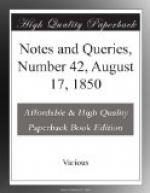“Barcaei, populi inter Colchos et Iberos morbo absumptos igni comburebant, sed qui in bello fortiter occubuissent, honoris gratia vulturibus devorandos objiciebant.”—.AElian. Hist. Anim. lib. x. “In Hyrcania (refert Cicero in Tusc. Quaest. lib. i. 45.) ali canes solitos fuisse, a quibus delaniarentur mortui, eamque optimam Hyrcanos censuisse sepulturam.”—Kirchmannus de Funer. Romanorum.
The appendix to this work may be consulted for this, and yet greater violations of the law of nature and nations.
“Apud saniores barbaros ab animalibus discerpi cadavera foedum semper ac miserabile creditum fuit. Foetus abortivi feris alitibutsque exponebantur in montibus aut locis aliis inaccessis, quin et ipsi infantes, &c. Fuit haec Asinina sepultura poena Tyrannorum ac perduellium. (Spondan. de Coemet. S. pp. 367. 387. et seqq.) Quam et victorum insolentia odiumque vulgi implacabile in hostes non raro exercuit.”—Ursinus Arbor. Biblicum.
Hyde accounts for the Persians who embraced the religion of the Magi not having adopted the two contrivances of corporal dissolution prevalent among civilised nations—cremation or burning, and simple inhumation—by the superstitious reverence with which they regarded the four elements. Sir T. Browne remarks that similar superstitions may have had the same effect among other nations.
Of the post-mortem punishments described by Ducange, the former was the customary sepulture of the Trogloditae; the latter corresponds with the rite of some of the Scythians recorded by Statius:
“At gente in Scythica suffixa cadavera
truncis,
Lenta dies sepelit putri liquentia tabo.”
I shall be obliged if you or a correspondent disposed “not only to teach but to communicate,” will kindly throw light on a passage, relating to the Troloditae, in Strabo, book xvi., where he relates, “Caprae cornu mortuis saxorum cumulo coopertis fuisse superimpositum.”
T.J.
Guy’s Porridge-pot (Vol. ii., p. 55.).—Your correspondent is quite correct, when he says “neither the armour nor pot belonged to the noble Guy.” He would have been a guy if he had worn the armour, seeing that it was made for a horse, and not for a man.
What the stout old lady who showed us the “relics of old Guy” in 1847 called “Guy’s breastplate,” and sometimes his helmet! is the “croupe” of a suit of horse armour, and “another breastplate” a “poitrel.” His porridge-pot is a garrison {188} crock of the sixteenth century, used to prepare “sunkits” for the retainers; and the fork a military fork temp. Hen. VIII.
The so called “Roman swords” are “anelaces,” and a couteau de chasse of the sixteenth and seventeenth centuries.
The “British weapon” is a hammer at arms temp. Hen. VIII., and “the halbert” a black bill temp. Hen. VII. The only weapons correctly described are the Spanish rapiers.




